For years, a CT scanner was top of the Whistler Health Care Centre's wish list, and with the donation of a $1.4 million scanner by General Electric as part of their support for the 2010 Winter Olympics it was a wish that came true in December 2009.
The CT Scanner turns three years old this month, with confirmation that service is to be increased for the scanner, with on-call hours added to the regular 40-hour per week schedule.
"It's working quite well," said Dennis Hummerston, the operations director for medical imaging for the Coastal Health Service Delivery Area. "Tuesday, Wednesday, Friday and Saturday are the main hours when (the CT scanner) is fully staffed from 10 a.m. to 8 p.m., and we will be implementing a limited call-in type of service for after hours so if something comes in like a head trauma or something along those lines we can perform that scan."
However, even with more after-hours service, many cases will still be sent to hospitals in the Lower Mainland. When injuries aren't immediately life threatening, Whistler's CT scanner can help to determine whether someone needs a higher level of emergency service. It also makes things more convenient for patients in Whistler and Pemberton that require scans for other medical reasons.
In the last fiscal period, April 2011 to March 2012, the CT scanner did about 1,900 scans, of which 416 were emergency cases. Open four days a week, that works out to roughly nine scans per day.
However, an average winter Saturday could be much busier, just as user numbers drop in the off-season.
"We do see a lot of ski and bicycle injuries, and we do a see a spike in volume during the winter and summer seasons... so (usage) is very seasonal in nature," said Hummerston.
He added that the expanded on-call service would be available starting in December, almost three years exactly after the CT scanner was commissioned. It's unknown how many additional scans could be taken each year, but at the time the scanner was installed it was suggested that it could handle 3,000 scans per year.
CT scanners use "X-ray computed tomography" to take detailed medical images in "slices," allowing doctors to generate a three-dimensional image of the inside of a person.
While that can be helpful in finding fractures that may not be obvious using conventional x-rays, tumors, internal bleeding or other medical issues, they are only given in certain circumstances because of the amount of radiation produced in a scan.
Dr. Bruce Mohr, medical staff president for the Whistler Health Care Centre, said that the scanner is well used.
"It's certainly changed the way that patients are referred," said Mohr. "It's kind of hard to give a short answer (on its impact) because it's used in many, many ways and in all types of conditions."
The immediate benefit was the ability to perform scans in Whistler without having to send patients to the city. They still do when the CT technician is not available, but the1,900 uses in 2011-2012 represents 1,900 trips to the city.
Another benefit is the ability to do CT scans on emergency patients that are already being referred to the city, speeding up the process for surgeons and other medical staff when the patients arrive in the hospital.
"For example, if you have an orthopedic patient with many kinds of fractures, and you know they may need surgery, then the surgeon (in the city) may ask for a CT scan to be done before they see the patient to determine how the surgery needs to be done," said Mohr. "It saves them time, in other words... which is good for the patients as well."
Mohr is still waiting to see how the additional on-call hours will work, but is glad to see that the CT scan will see more use going forward.
"The more we can use it, the more it's available, the better," he said.




